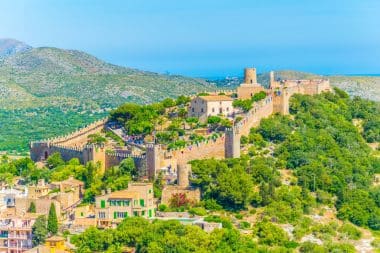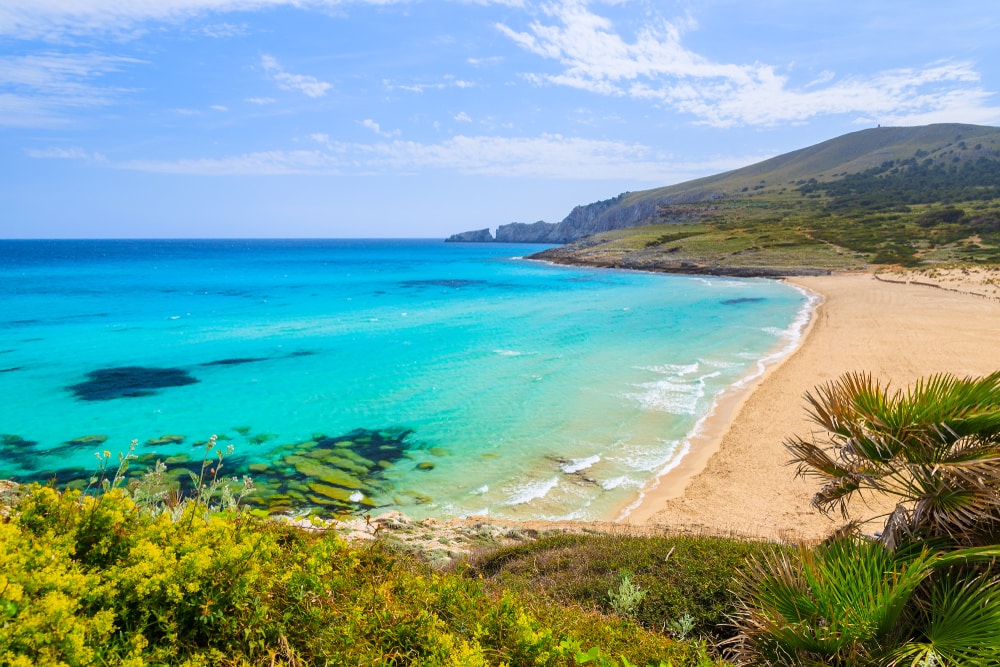If you want to avoid the tourist crowds on Mallorca and relax in peace on the beach or while hiking, the settlement of Cala Mesquida, which has only about 40 inhabitants, is the right place for you. Cala Mesquida is located in the northeast of Mallorca. Cala Mesquida is best known for the bay of the same name, which borders the settlement. There you can lie wonderfully in the fine sand. If you are more in the mood for active relaxation, you can take a trip to the mountains on foot or by mountain bike around Cala Mesquida. In addition, the nearby small town of Capdepera attracts visitors with historic buildings and a colourful market.
A natural dune area: Cala Mesquida
The bay of Cala Mesquida is 350 metres long and consists of a crescent-shaped sandy beach in front of which the sea water shimmers crystal clear in all shades of turquoise to dark blue. Since there are only a few hotels, holiday homes and guesthouses in the area, tourists are often still among themselves on their beach section. Part of the dune area of Cala Mesquida is protected. Seagulls and cormorants nest there and the area is surrounded by pine trees. There is a little infrastructure at Cala Mesquida, there is a bar and a restaurant and also showers, but no changing rooms on the beach. The range of sports on offer is dignified: holidaymakers can rent a pedal boat and snorkel in the shallow sea water. In the low season, the weather conditions at Cala Mesquida are also suitable for surfers. Several diving schools also offer diving courses at Cala Mesquida.
On foot and by bike into the mountains around Cala Mesquida
Directly from Cala Mesquida, a designated hiking trail leads to the summit of the Talaia de Son Jaumell mountain at an altitude of 273 meters. The hike leads through barren landscapes that are steeply tapering and offer little shade. It is therefore best to do this hike in the low season, or in the morning hours in summer. Before reaching the summit, it is particularly steep and hikers should have a certain surefootedness here. Once at the summit, an almost breathtaking view stretches over Cala Mesquida and the neighboring Cala Rajada to Cap Formentor and over the Mediterranean Sea.
By the way, the mountain Talaia de Son Jaumell shares its name with a tower of the same name, which was once built on its summit. Today, only ruins of this nine-meter-high round tower from the 16th century remain. The tower used to serve as an observation tower. From there, guards were supposed to spot attacking pirate ships early on and sound the alarm in the event of an imminent attack. If you still have energy after this hiking tour, you can ride from Cala Mesquida via a seven-kilometre-long cycle path to Cala Ratjada, which could already be visited from above. On the way you pass sheep and goat pastures.
A trip to the historic old town of Capdepera

The town of Capdepera, with a population of about 12,000, is one of the largest cities in the area. Capdepera is located seven kilometres south of Cala Mesquida and can be easily reached by rental car or by bike. Throughout the city, the typical stone houses built of natural stone catch the eye. The inhabitants of Capdepera attach great importance to a positive image of their city and so many of these quaint stone houses are decorated with colorful flower arrangements. Narrow streets of cobblestones wind through the old town of the village, which you can roam on foot during a walk. You should definitely visit the Castell de Capdepera.
It was built as early as the 14th century and used to form a complete fortification with several buildings. The Castell de Capdepera is located above the city and can be reached after a sweaty climb from the city center. The Castell de Capdepera was built on the 159-metre-high summit of the Puig de Capdepera mountain. The Castell de Capdepera is still surrounded by a fortification wall that encloses a floor area of more than 8,000 square meters. Built in the 10th century, the Torre d’en Miquel Nunis adorns the highest point of the castle and was reached by the island’s former Islamic besiegers. In addition to a church, the cistern from the 15th century located on the church forecourt is impressive. In addition, an 18th-century governor’s house has been preserved, which now houses the Castell de Capdepera Museum.


